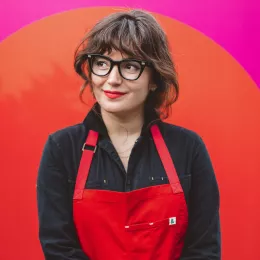Every year, ICE publishes three issues of The Main Course, our school newsletter. In addition to info about our programs and our recreational cooking class listings, it is jam packed with news and articles about trends and professionals making headlines. In the April edition, Editor Kiri Tannenbaum spoke with The Spotted Pig Chef April Bloomfield about her restaurant and her new book, "A Girl and Her Pig." We’re sharing the interview here on DICED. First up, a look at what it’s like to take experience as a restaurant chef and translate it into a book.
British-born chef April Bloomfield has been credited with starting the “gastropub revolution” in New York City.She and restaurateur Ken Friedman launched The Spotted Pig in February of 2004 and since then the eatery has earned one star from the Michelin Guide for six consecutive years. In 2010, the duo expanded their restaurant empire inside the Ace Hotel, first with The Breslin Bar & Dining Room, and later with the John Dory Oyster Bar, which earned a glowing two-star review from The New York Times.
Even though her illustrious career seems like it was meant to be, Bloomfield accidentally fell into her career after missing an examination to begin training as a police officer. So instead she followed in her sister’s footsteps to culinary school at Birmingham College and eventually went on to cook at London’s acclaimed River Café. Under the guidance of Ruth Rogers and Rose Gray, Bloomfield learned that good ingredients speak for themselves. Nearly a decade after leaving her mentors, her first cookbook, "A Girl and Her Pig," hit shelves in April 2012. The Main Course met with Bloomfield upstairs at The Breslin to discuss her book endeavor, her thoughts on being a chef and restaurateur and that oh-so famous burger.
How long was your cookbook in the making?
It was a whole year to write it, to test recipes and tell the stories. It was a great experience and working with JJ [Goode] was amazing. He’s such a good writer, very talented, and we worked well together. [You can read about JJ’s career as a collaborative food writer here on DICED.]
In the foreword to the book JJ referred to you as “vegetable savant.” What do you think about that?
Did he? That’s a good thing … I think. I love cooking vegetables. They’re just fun to cook and they’re so versatile. We’re planning on doing a vegetable book together, which is very exciting.
How difficult was it to translate your restaurant’s recipes for a home cook?
It took a second because I’d never done it before. I was doing a process that I thought was quite natural and then it didn’t quite work out. I thought, “This is going to take forever.” So what I had to do was just scratch what I’d just done then restart. I wrote the ingredients down, but without putting weights and measures in, and then I wrote the method. I used an iPad so it was really efficient. Then I created the recipes and I had time to write little notes about why I liked the recipe, and JJ did a lot of video.
What about the cover photo of you with a pig slung around your shoulders? That may be polarizing to some — was there a message behind that?
No. It’s called "A Girl and Her Pig." Originally, we were going to do an illustration, but myself, my editors and publishers decided that it would be a stronger book if it had a photograph on the front. I have a really great friend, Martin Schoeller, who took that photograph. It was very feminine in a way but quite strong.
It also says a lot about you, it’s pretty brazen.
What? To have a dead pig on the front? [Chuckling] Well, it’s very natural for me. I don’t think it’s weird or offensive because I work with food, and I work with farmers all the way from the breeding to the killing to bringing it to the restaurant to the customer. We see the whole step through, so it was just very natural when we chose it. I didn’t think anything of it.
Click here for Part Two of our interview with April Bloomfield.




